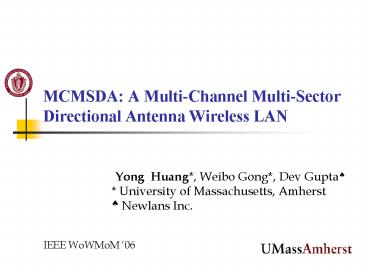MCMSDA: A MultiChannel MultiSector Directional Antenna Wireless LAN - PowerPoint PPT Presentation
1 / 21
Title:
MCMSDA: A MultiChannel MultiSector Directional Antenna Wireless LAN
Description:
MCMSDA: A Multi-Channel Multi-Sector Directional Antenna Wireless LAN ... How to detour the traffic when some APs are congested? Goal: Minimize total transmission time ... – PowerPoint PPT presentation
Number of Views:32
Avg rating:3.0/5.0
Title: MCMSDA: A MultiChannel MultiSector Directional Antenna Wireless LAN
1
MCMSDA A Multi-Channel Multi-Sector Directional
Antenna Wireless LAN
- Yong Huang, Weibo Gong, Dev Gupta?
- University of Massachusetts, Amherst
- ? Newlans Inc.
IEEE WoWMoM 06
2
Outline
- Motivation
- Idea and MAC design
- Scheduling problem and solution
- Boosting scheduling algorithm
- Conclusion
3
Motivation
- Current Wireless LANs
- Pros convenient, low cost
- Cons Low bandwidth and poor security
- Mostly using one channel
- Opportunity
- Multiple non-overlapping channels
- Multi-Sector Directional Antennas
- Why dont we utilize them simultaneously?
- MCMSDA WLAN
4
A simple MSDA model
5
MCMSDA WLAN Architecture
- Each sector of the user node will never see
two APs with same color
6
IDEA of MAC
Scheduling
7
MAC Design -Time Division Multiple Access (TDMA)
- Channel time is divided into frames
- Frame includes
- Beacon broadcasting scheduling results
- CP contention period to transmit control
messages - CFP contention free period for data transmission
- Scheduling algorithm is executed every frame to
provide channel assignment for next frame
8
Scheduling problem
- How to detour the traffic when some APs are
congested? - Goal Minimize total transmission time
- Assumptions
- Channel switching time is ignored (but any
request can ONLY be carried by one AP during one
scheduling period) - User nodes can estimate effective throughput to
every APs - Decision variables X(i,j) whether node i uses AP
j or not (0-1 variable) - An integer programming problem
9
Problem formulation
- Notations
- m number of APs
- n number of stations
- qi,j effective throughput between station i and
AP j - bi requested data length of station i
- xi,j 0-1 decision variable
- ti,j transmission time used by station i via AP
j - Tj available CFP time of AP j
- Goal Minimize the total transmission time
- Subject to
- AP constraints
- Station constraints
10
Input and output
- Input
- Available channel time of every AP Tj
- User loads bi
- Throughput between every ltUser, APgt qi,j
- Output
- Decision variable Xi,j
11
Scheduling solution
- Why not using well known solutions? Scheduling
time is very limited - Lagrangian Relaxation method
- Good for decomposable problem
- Lagrangian multipliers (?1, ?2,, ?m) can be
viewed as virtual price and can be re-used to
reduce scheduling time - These virtual prices provide more information for
network management
12
Scheduling algorithm
- Lagrangian function
13
Simulation
- 4 areas
- 11 Mbps to closest AP and 5M to nearby APs, 1Mbps
to farthest AP - 70 load in area 1, 10 load in every other area
- Users have same channel request length
- Superframe length 10ms
14
Simulation (contd)
- Parameters
- Network Size number of node
- Channel request length
- Two set of simulations
- Set 1Fixed network size (80 users), various
channel request length (1kb-20kb) - Set 2 Fixed channel request length (6kb),
various number of nodes (100-250 users) - Metrics
- Aggregated Throughput
- Scheduling time
- Compare to Best WAP strategy
- Best WAP user node always choose the AP with
highest Throughput - Duality Gap (related error between scheduled
objective value and the optimal value) lt 5 even
when of users is 200
15
Aggregate throughput
Set 1
Set 2
- Higher aggregate throughput than Best WAP strategy
16
Scheduling Time
Set 1
Set 2
- Complexity of solving all sub-problems o(mn)
- How to accelerate the scheduling process?
17
Incremental-adjusting method
- Key idea use l of previous round as initial
value assuming the user statistic behavior is not
varying much
18
Backup-resource method
- Key idea
- Use same l for several superframes
- Reserve part of channel time to accommodate the
channel resource violation - a percentage of reserved resource
- l is not the accurate price and some requests
will not be granted - How the a affect the scheduling time and request
granted ratio?
19
Backup-resource method (contd)
Scheduling time
Request granted ratio
20
Conclusion
- Wireless LAN performance can be improved by
combining Multi-channel and Multi-sector
directional antennas - Lagrangian relaxation based pricing algorithm can
quickly reach a good sub-optimal solution - Accelerate the scheduling process is possible
with minor performance degradation
21
Thank you!!
- http//tennis.ecs.umass.edu/yhuang
- yhuang_at_ecs.umass.edu































